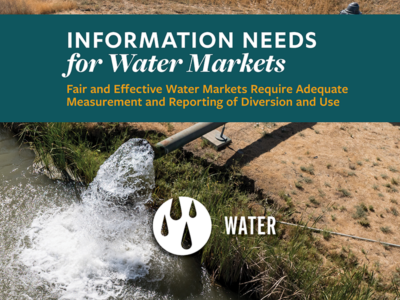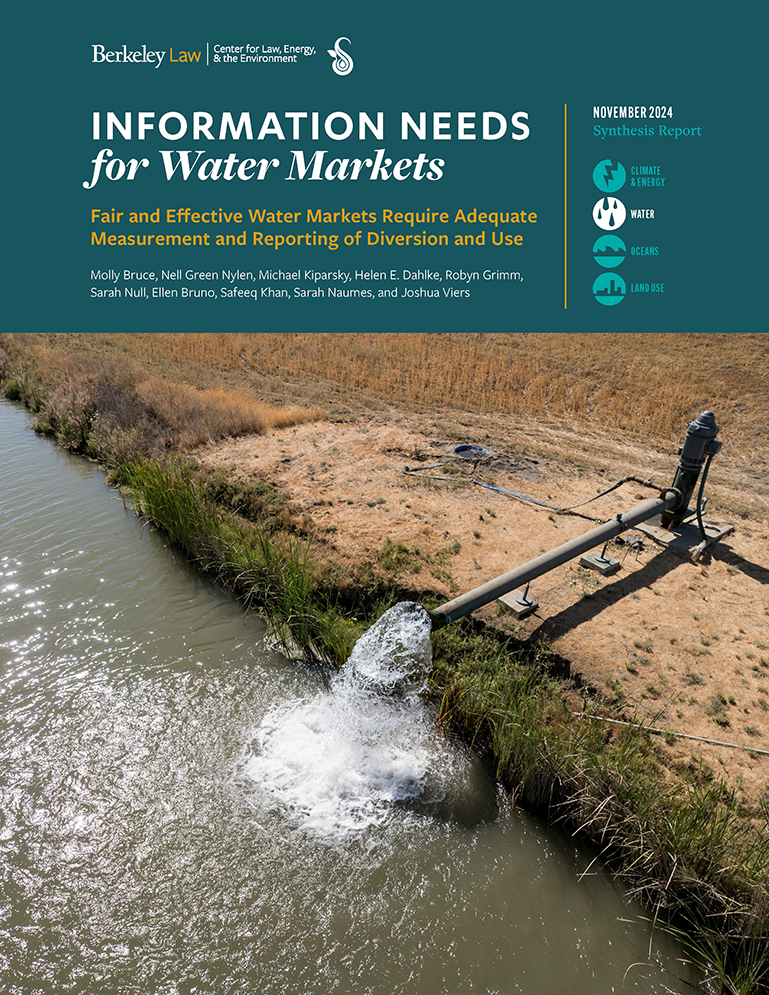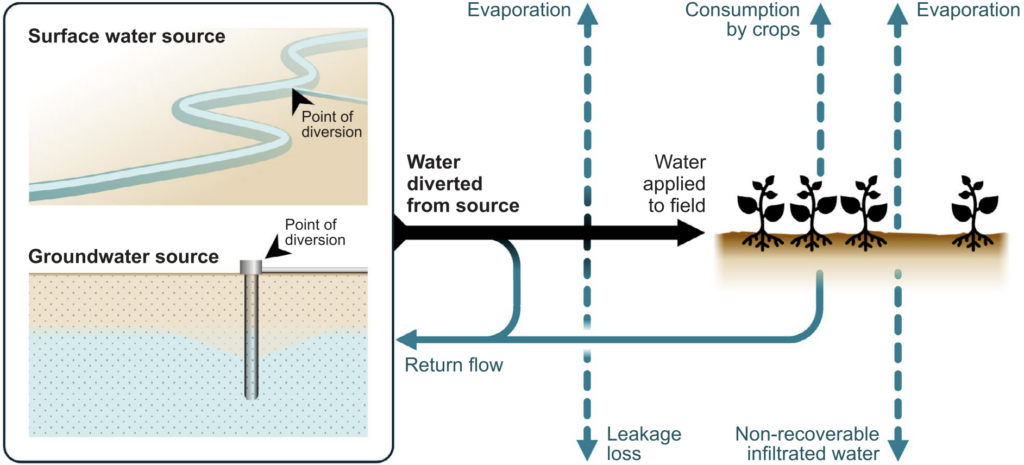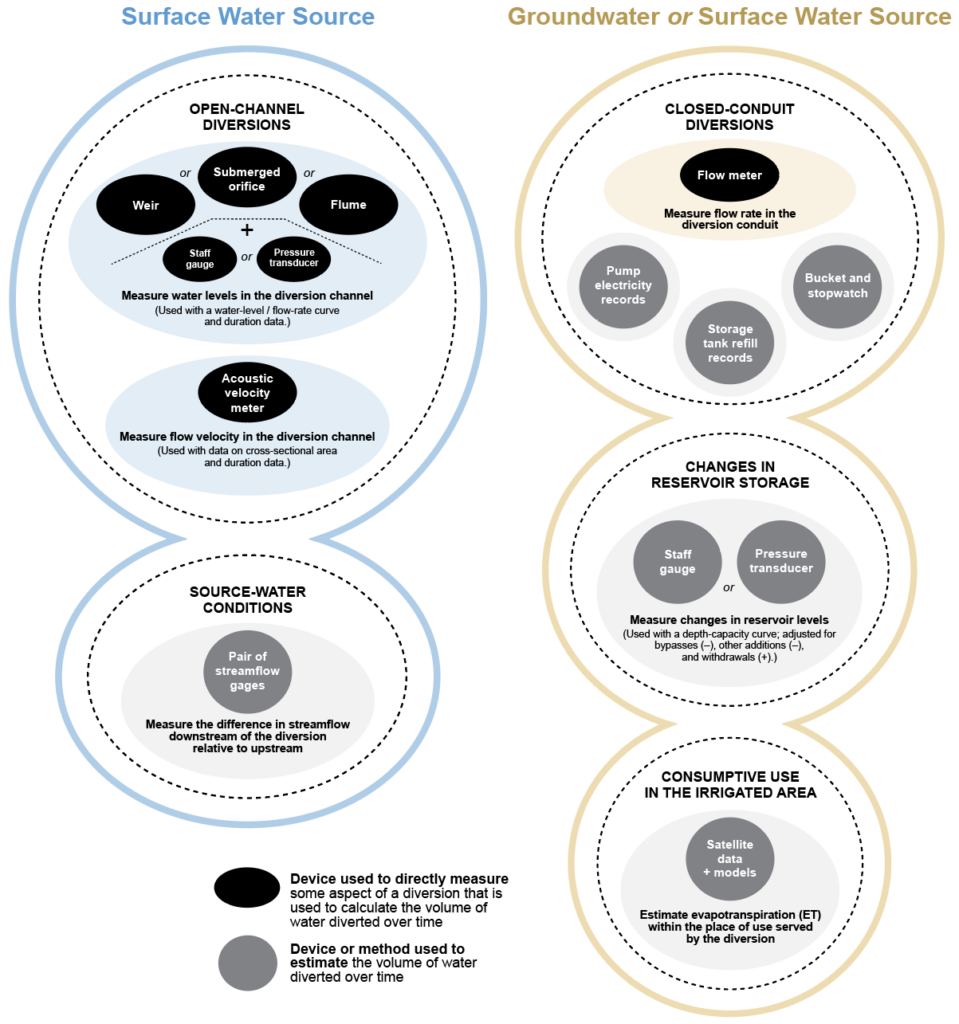Meeting information needs for water markets: Understanding water diversion and use
Legal Planet: Environmental Law and Policy 2024-11-14

by Nell Green Nylen and Molly Bruce
 Water scarcity is a growing problem for agriculture and ecosystems across the U.S. Southwest. In many areas, unsustainable water use has overstretched local water supplies, and climate change is making these supplies more volatile.
Water scarcity is a growing problem for agriculture and ecosystems across the U.S. Southwest. In many areas, unsustainable water use has overstretched local water supplies, and climate change is making these supplies more volatile.
Water markets have the potential to enhance climate resilience by helping water users adapt to short-term variations in water supply and by easing long-term transitions to more sustainable levels of water use. However, this promise can only be realized if markets are truly fair and effective—able to achieve their intended goals without causing negative side effects.
Our new report examines a foundational prerequisite for fair and effective water markets: adequate information about water diversion and use. This information is necessary because it defines what can be traded, enables market administrators and participants to track trading transactions and changes in the physical and legal availability of water, and facilitates assessment of the impacts trading has on others.
We wanted to know whether current water measurement and reporting in the U.S. Southwest are capable of meeting these basic information needs. Using expert discussions and additional research, we explored:
- What information about water diversion and use (see figure) is currently available in the U.S. Southwest? Why and how is it measured and reported?
 What happens to water after someone diverts (withdraws) it from a natural surface water or groundwater source, such as a stream or aquifer, to irrigate an agricultural field? “Water use” occurs when the diverted water is lost through evaporation, leakage, consumption by crops, or other processes.
What happens to water after someone diverts (withdraws) it from a natural surface water or groundwater source, such as a stream or aquifer, to irrigate an agricultural field? “Water use” occurs when the diverted water is lost through evaporation, leakage, consumption by crops, or other processes.- What diversion and use information is needed to support fair and effective water markets that build resilience for agriculture and ecosystems?
- What gaps exist between what information is needed and what is available?
- How can those gaps be bridged?
We share our findings in a new synthesis report, “Information Needs for Water Markets: Fair and Effective Water Markets Require Adequate Measurement and Reporting of Diversion and Use.”
Here are four key takeaways:
1. Institutional context affects water measurement and reporting.
The legal, political, social, and environmental conditions in an area shape water measurement and reporting practices and whether those practices produce adequate information about water diversion and use to support a water market. We found that many different types of entities measure water diversions and water use. Key drivers include mandatory requirements intended to support water rights administration and diverters’ water planning and management needs.
 Examples of devices and methods used to measure or estimate water diversions.
Examples of devices and methods used to measure or estimate water diversions.2. Technical realities and practical considerations affect what gets measured.
The entities that measure water diversions select measurement and reporting technologies based on their goals, site-specific conditions, regulatory requirements, and other considerations such as cost, data accessibility, and data usability. There are always tradeoffs. Generally, less sophisticated measurement and reporting devices and methods offer less accuracy and precision at lower upfront cost. In contrast, more sophisticated methods that provide more accurate and timely data often have higher upfront costs but can sometimes save money in the long run.
3. Current water measurement and reporting often fall short.
Where water measurement and reporting are inadequate, water markets carry a heightened risk of causing unintended consequences for communities and ecosystems.
Our research suggests that water measurement and reporting in the U.S. Southwest are often inadequate to meet the basic needs they are intended to serve, let alone to support fair and effective water markets. It is often not clear how, when, or where water is being diverted and used and what impacts are occurring. The data-sufficiency gap appears to be widest for small diversions, diversions from small streams and ungaged reaches of larger streams or rivers, groundwater diversions, diversions during dry periods, and the amount of diverted water that is consumptively used.
There is a clear need for more timely, accurate, and accessible data on water rights, water diversions, water use, and changing surface and groundwater conditions—data that clarifies how much water a party can trade and the impacts of trading on particular communities and ecosystems.
4. Opportunities exist to advance fair and effective water markets (and water management in general).
In our report, we outline a vision for fair and effective water markets that enhance climate resilience for agriculture and ecosystems. That vision includes clear market goals, a good understanding of the risks and benefits of water trading, and adequate information about water diversion and use. It also includes clear trading rules designed to reflect local conditions and minimize potential harm to third parties and the environment. Information about trading transactions and prices is transparent and publicly accessible. Finally, the market is adaptively managed, with frequent evaluation and adjustment and plans in place to address serious unintended consequences that might arise.
We identify concrete steps different parties can take to help build the information base necessary to advance this vision of fair and effective water markets.
Improving understanding of water diversion and use:
- States can establish or improve requirements for measuring and reporting to help fill existing information gaps, support more effective water rights administration, and enable timely and accurate evaluation of potential water transfers.
- State agencies can develop and maintain a publicly accessible data system for reporting to reduce data fragmentation, inaccuracy, incompatibility, and inaccessibility.
- Government agencies, researchers, and others can provide guidance and educational outreach to help diverters understand measurement and reporting requirements and technical options.
- Diverters can expand the use of telemetry to enable near-real-time measurement and reporting. Other actors can take steps to support the broader adoption of telemetry.
- Researchers, diverters, and government agencies can work to develop a more complete picture of consumptive use and to better integrate groundwater and surface water data to support more holistic analysis of the impacts of water diversions, consumptive use, and water trading. State legislatures can provide funding and policy support for these actions.
Increasing the accuracy and utility of reported data:
- States can establish clear data standards for collecting and reporting data.
- Government agencies, researchers, and others can provide guidance to help diverters understand applicable measurement and reporting requirements and improve the quality of the data they collect and report.
- Researchers, diverters, and government agencies can incorporate quality assurance / quality control (QA/QC) measures into their reporting and data management systems and workflows.
- Researchers and government agencies can examine similarities and differences in different parties’ data needs and how well available data are meeting those needs.
Addressing funding and affordability challenges:
- Various entities can work to identify stable, long-term funding sources for collecting, maintaining, and analyzing water rights data—including diversion and use data.
- Various entities can identify critical broadband gaps that must be addressed to support fully telemetered measurement and reporting systems.
- States can subsidize the buildout of telemetered measurement and reporting for under-resourced diverters, such as via cost-sharing programs.
- Researchers and state agencies can develop and share open-source platforms for reporting and data management.
Creating information conditions that can supporting fair and effective water markets will take work, political will, and financial resources. However, we think it is feasible. What is more, the actions we identify here will benefit water management in general. In fact, many will be crucial for effective climate adaptation in the Southwest, with or without water markets.
Learn about CLEE’s past work on water markets.
We developed this report in collaboration with our coauthors: Michael Kiparsky, Helen E. Dahlke, Robyn Grimm, Sarah Null, Ellen Bruno, Safeeq Khan, Sarah Naumes, and Joshua Viers.
This work is part of the Secure Water Future project and was supported by Agriculture and Food Research Initiative Competitive Grant no. 2021-69012-35916 from the USDA National Institute of Food and Agriculture. We thank the group of experts from California, New Mexico, and Utah who participated in our convening on this topic and our SWF colleagues who helped facilitate the convening.